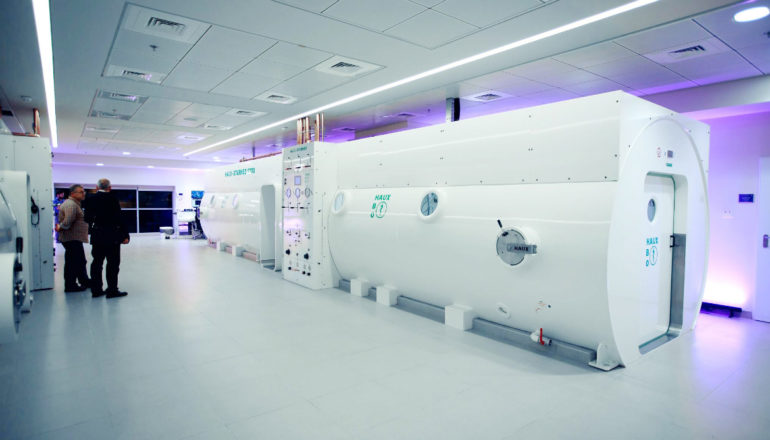Hyperbaric Oxygen Therapy as a Fibromyalgia Treatment
A Breath of Fresh Air
There is a new treatment option being researched that is quite litterly a breath of fresh air. A study at Rice University and Israeli institutes suggest that using hyperbaric oxygen therapy as a treatment for fibro, many have noticed a dramatic improvement in their condition. The best results are from those had some form of brain trauma experienced. As we know, there is currently no cure for fibromnyalgia but right now there are rumors floating around that hyperbaric oxygen therapy could be a cure for the disorder.
Women with fibromyalgia were able to drastically reduce and even completely eliminate their use of pain medication after a treatment regimen in a hyperbaric oxygen chamber.
Fibromyalgia is a chronic pain syndrome that can be accompanied by—and perhaps is related to—other physical and mental conditions that include fatigue, cognitive impairment, irritable bowel syndrome, and sleep disturbance.


The findings of a clinical trial show the painful condition improved in every one of the women who completed two months of the new therapy. Brain scans before and after treatment support the theory that abnormal conditions in pain-related areas of the brain may be responsible for the syndrome.
Pain in the brain
More than 90 percent of people diagnosed with the syndrome are women, says Eshel Ben-Jacob, adjunct professor of biosciences at Rice University and a professor of physics at Tel Aviv University.
“Symptoms in about 70 percent of the women who took part have to do with the interpretation of pain in their brains,” he says. “They’re the ones who showed the most improvement with hyperbaric oxygen treatment. We found significant changes in their brain activity.”
Scientists have not pinned down the syndrome’s cause, although a recent study identifies a possible RNA-based biomarker for its diagnosis. A variety of treatments from drugs to lifestyle changes have been tried to relieve patients’ suffering, with limited success, Ben-Jacob says.
“Most people have never heard of fibromyalgia,” he says. “And many who have, including some medical doctors, don’t admit that this is a real disorder. I learned from my MD friends that this is not the only case in which disorders that target mainly women raise skepticism in the medical community as to whether they’re real or not. However, these days there are increasing efforts to understand the effect of gender on body disorders.”
Pure oxygen
Researchers at the Sagol Center for Hyperbaric Medicine and Research at the Assaf Harofeh Medical Center and Tel Aviv University were studying post-traumatic brain injury patients when they realized hyperbaric oxygen treatment could help patients with fibromyalgia.
“Patients who had fibromyalgia in addition to their post-concussion symptoms had complete resolution of the symptoms,” says Shai Efrati, head of the research and development unit at the Assaf Harofeh Medical Center and a member of the Sagol School of Neuroscience at Tel Aviv University and lead author of the study that is published in PLOS ONE.
Hyperbaric oxygen chambers that expose patients to pure oxygen at higher-than-atmospheric pressures are commonly used to treat patients with embolisms, burns, carbon monoxide poisoning, and decompression sickness (known to divers as “the bends”), among many other conditions.
One effect of exposure is to push more oxygen into a patient’s bloodstream, which delivers it to the brain. Earlier trials found HBOT induces neuroplasticity that leads to repair of chronically impaired brain functions and improved quality of life for post-stroke and mild traumatic brain injury patients, even years after the initial injury.
Some patients will likely require follow-up sessions, Efrati says. “The abnormalities in brain regions responsible for the chronic pain sensation in fibromyalgia patients can be triggered by different events. Accordingly, the longterm response may be different.
“We have learned, for example, that when fibromyalgia is triggered by traumatic brain injury, we can expect complete resolution without any need for further treatment. However, when the trigger is attributed to other causes, such as fever-related diseases, patients will probably need periodic maintenance therapy.”
Fewer pain meds
The clinical trial involved 60 women who had been diagnosed with fibromyalgia at least two years earlier. A dozen left the trial for various reasons, but half of the 48 patients who completed it received 40 HBOT treatments five days a week over two months. The 90-minute treatments exposed patients to pure oxygen at two times the atmospheric pressure.
The other half were part of a crossover-control group. They were evaluated before the trial and after a control period that saw no improvement in their conditions. After the two-month control, they were given the same HBOT treatment as the first group and experienced the same relief.
The successful treatment enabled patients to drastically reduce or even eliminate their use of pain medications. “The intake of the drugs eased the pain but did not reverse the condition, while HBOT did reverse the condition,” the researchers write.
The findings warrant further study, Efrati says. “The results are of significant importance since, unlike the current treatments offered for fibromyalgia patients, HBOT is not aiming for just symptomatic improvement.
“HBOT is aiming for the actual cause—the brain pathology responsible for the syndrome. It means that brain repair, including even neuronal regeneration, is possible even for chronic, long-lasting pain syndromes, and we can and should aim for that in any future treatment development.”
Sources:
Mike Williams Rice – futurity.org
Rice University– Hyperbaric hope for fibromyalgia sufferers




Have you tried HBOT for hypoanemia aassociated with COPD and L
egionnaires Diseasse? I had to increase my oxygen flow. Wonder if this would help?
Interesting, I am not sure if that would help or not for fibro. I’ll look into it